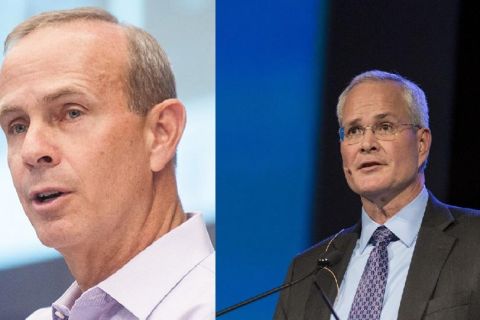Merge Electric Fleet Solutions’ president and CEO Glen Stancil recently sat down with Hart Energy to discuss the biggest opportunities and challenges for his Houston-based company.
Merge helps other companies electrify their fleets and their employees’ personal vehicles.
Stancil discussed electric vehicle (EV) tax credits and why they’re not all they’re cracked up to be, barriers to adoption, infrastructure workarounds and how Merge is trying to gain traction in oil capitals like Midland, Texas, in an interview with Hart Energy’s International Managing Editor Pietro D. Pitts.
Pietro D. Pitts: What is Merge doing in the EV space?
Glen Stancil: Merge is a next-generation fleet management company. Today's fleet management companies provide vehicle services to businesses that run fleets. Primarily their services are acquiring and disposing of vehicles. It's very much a transactional buying-and-selling process, and lots of companies rely on it to outsource the transactional elements dealing with vehicles.
EVs are a little different. You've got to make sure there's sufficient capability in that EV for the use case [that] you're going to put it into, and then plan the charging and the vehicle together. So, it's a joint decision and you've got to think about where the infrastructure is going to go for that vehicle. Merge uses a data-driven approach to look at how the current fleet gets used to find the best candidates are for deployment and the charging infrastructure that's required. Then we build a transition plan for the fleet, which includes the vehicles and the charging infrastructure, and we help [companies] execute that transition plan as a set of services.

Once they [oil and gas workers] understand the capability of the truck… they're very impressed by the frunk, the torque, the horsepower and then the ability to take power off the vehicle. — Glen Stancil, Merge
PDP: Are there usual incentives to buy EVs offered to employees that are driving fleet vehicles?
GS: There are two different programs. One has to do with [the fact] a lot of those vehicles from the fleet are now take-home, especially post-COVID. One element of what we do is provide home charging that effectively the company is paying for in order to get that fleet vehicle charged at home. The second is what I call an employee program, where you incent employees who aren't necessarily driving company vehicles to go electric with their personal vehicle.
PDP: Is home charging more cost-effective for an employee compared to at work or some other public site?
GS: There are a lot of reasons why home charging can be economic. Many employees can cost-effectively utilize a panel in their garage for between $500 to $1,500. Also, employees don't pay the demand charges like commercial companies. By contrast, the power in a parking structure or open parking lot can be much more expensive on an upfront and on-going basis.
PDP: How have oil and gas sector workers in Midland, Texas, a market Merge has targeted, taken to the idea of using an EV like the Ford F-150 Lightning?
GS: Once they understand the capability of the truck… they're very impressed by the frunk [trunk in the front of the vehicle], the torque, the horsepower and then the ability to take power off the vehicle. Those are the four things that sell people on that truck. I think the acceptance is there once you have the conversation, and they really appreciate that electricity comes mostly from the gas they produce.
PDP: In terms of the energy transition and the move from fuel vehicles to EVs, we’re still not there yet, right?
GS: No, we still have a long way to go in decarbonizing the transport sector. While EVs have hit a tipping point at 5% of new car sales, they struggle to address some use cases today. So, we must continue. advancing low-carbon and no-carbon fuels of all types to ensure there is a cost-effective option for every use case, EVs are just one piece of the puzzle.
PDP: Is Merge only focused on the energy sector?
GS: We focus on other sectors including health care, renewables, utilities, lots of different areas. We tend to focus on light-duty cars, trucks and vans, partially because that's where the economics work. You certainly have medium and even heavy-duty [vehicles], but the economics can be challenging. For instance, a semi-tractor that uses diesel might cost $180,000 and the electric version might cost $450,000. It's really tough to get the economics and the payback to work on that. Right now, with electric light there's scale, there's volume. There's plenty of opportunity.
PDP: Is there still an issue now with EV prices and a lack of charging stations?
GS: The two big barriers right now to EV adoption are vehicle price and broad, deep and reliable charging. So, lots of places, depth where it is, and it has to work great. Those are the two big barriers.
Merge focused on fleets because the dependance on public charging is minimal, and fleets take a total cost of ownership perspective to a purchase. It may cost more upfront, but if I'm saving on fuel and maintenance and time to pay that back, I'm okay with that. By contrast, consumers focus on the sticker price or a monthly payment.
PDP: Does the U.S. have enough of the necessary minerals to really make EVs that are truly North American?
GS: Not today. We have to develop new lithium sources [and others], which takes time.
PDP: If that's an issue, is that going to slow development of EVs going forward?
GS: There is global capacity to meet the U.S. EV demand of critical minerals in the short term. However, many of those sources are not considered secure, and the U.S. does not have the capacity to satisfy our own demand today -- much less tomorrow. The IRA is structured to incent the development of minerals capacity in the U.S. and other secure locations by tying tax credit value to the mineral sources.
RELATED
Biden’s Administration Offers Credits for New Clean Vehicles
PDP: With the tax credit and talk about energy security, what is the biggest challenge facing the EV industry?
GS: I think vehicle pricing is our big challenge this year. Last year I would have said vehicle availability, but between rising prices and rising interest rates, I think vehicle availability is going to become less of an issue than vehicle affordability in 2023.
PDP: What’s the biggest opportunity facing the EV industry this year?
GS: I think the employers supporting their employees going electric would be a really big opportunity this year. In addition to aligning with the company’s ESG commitments, an employee program creates real attraction, retention and return-to-office benefits for the company.
Recommended Reading
NGL Growth Leads Enterprise Product Partners to Strong Fourth Quarter
2024-02-02 - Enterprise Product Partners executives are still waiting to receive final federal approval to go ahead with the company’s Sea Port Terminal Project.
Equinor Releases Overview of Share Buyback Program
2024-04-17 - Equinor said the maximum shares to be repurchased is 16.8 million, of which up to 7.4 million shares can be acquired until May 15 and up to 9.4 million shares until Jan. 15, 2025 — the program’s end date.
Exxon, Chevron Tapping Permian for Output Growth in ‘24
2024-02-02 - Exxon Mobil and Chevron plan to tap West Texas and New Mexico for oil and gas production growth in 2024, the U.S. majors reported in their latest earnings.
CEO: Coterra ‘Deeply Curious’ on M&A Amid E&P Consolidation Wave
2024-02-26 - Coterra Energy has yet to get in on the large-scale M&A wave sweeping across the Lower 48—but CEO Tom Jorden said Coterra is keeping an eye on acquisition opportunities.
California Resources Corp. Nominates Christian Kendall to Board of Directors
2024-03-21 - California Resources Corp. has nominated Christian Kendall, former president and CEO of Denbury, to serve on its board.






